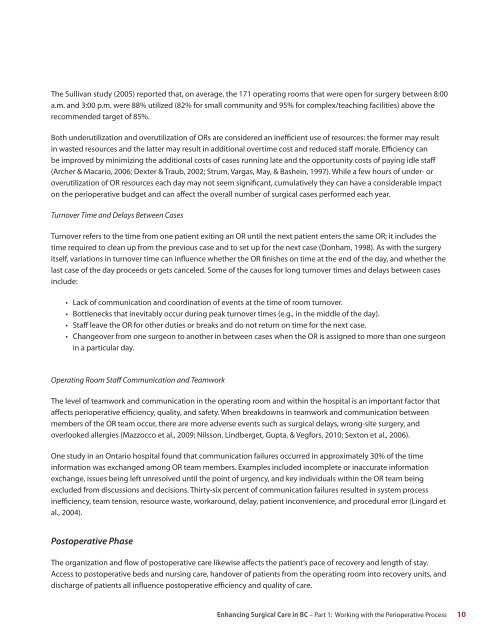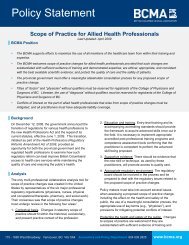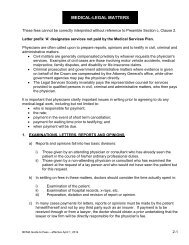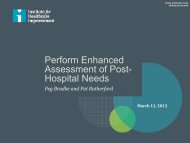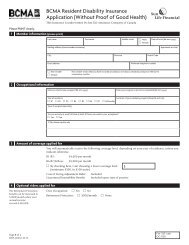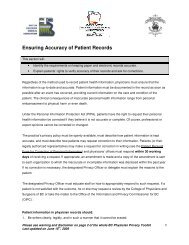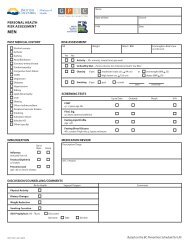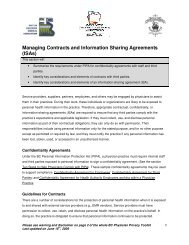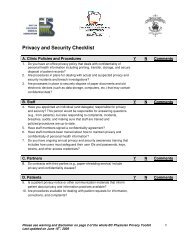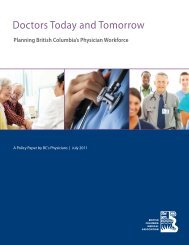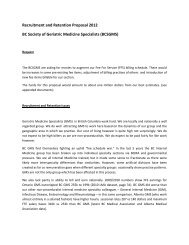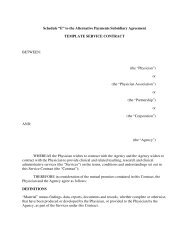Enhancing Surgical Care in BC - British Columbia Medical Association
Enhancing Surgical Care in BC - British Columbia Medical Association
Enhancing Surgical Care in BC - British Columbia Medical Association
Create successful ePaper yourself
Turn your PDF publications into a flip-book with our unique Google optimized e-Paper software.
The Sullivan study (2005) reported that, on average, the 171 operat<strong>in</strong>g rooms that were open for surgery between 8:00<br />
a.m. and 3:00 p.m. were 88% utilized (82% for small community and 95% for complex/teach<strong>in</strong>g facilities) above the<br />
recommended target of 85%.<br />
Both underutilization and overutilization of ORs are considered an <strong>in</strong>efficient use of resources: the former may result<br />
<strong>in</strong> wasted resources and the latter may result <strong>in</strong> additional overtime cost and reduced staff morale. Efficiency can<br />
be improved by m<strong>in</strong>imiz<strong>in</strong>g the additional costs of cases runn<strong>in</strong>g late and the opportunity costs of pay<strong>in</strong>g idle staff<br />
(Archer & Macario, 2006; Dexter & Traub, 2002; Strum, Vargas, May, & Bashe<strong>in</strong>, 1997). While a few hours of under- or<br />
overutilization of OR resources each day may not seem significant, cumulatively they can have a considerable impact<br />
on the perioperative budget and can affect the overall number of surgical cases performed each year.<br />
Turnover Time and Delays Between Cases<br />
Turnover refers to the time from one patient exit<strong>in</strong>g an OR until the next patient enters the same OR; it <strong>in</strong>cludes the<br />
time required to clean up from the previous case and to set up for the next case (Donham, 1998). As with the surgery<br />
itself, variations <strong>in</strong> turnover time can <strong>in</strong>fluence whether the OR f<strong>in</strong>ishes on time at the end of the day, and whether the<br />
last case of the day proceeds or gets canceled. Some of the causes for long turnover times and delays between cases<br />
<strong>in</strong>clude:<br />
• Lack of communication and coord<strong>in</strong>ation of events at the time of room turnover.<br />
• Bottlenecks that <strong>in</strong>evitably occur dur<strong>in</strong>g peak turnover times (e.g., <strong>in</strong> the middle of the day).<br />
• Staff leave the OR for other duties or breaks and do not return on time for the next case.<br />
• Changeover from one surgeon to another <strong>in</strong> between cases when the OR is assigned to more than one surgeon<br />
<strong>in</strong> a particular day.<br />
Operat<strong>in</strong>g Room Staff Communication and Teamwork<br />
The level of teamwork and communication <strong>in</strong> the operat<strong>in</strong>g room and with<strong>in</strong> the hospital is an important factor that<br />
affects perioperative efficiency, quality, and safety. When breakdowns <strong>in</strong> teamwork and communication between<br />
members of the OR team occur, there are more adverse events such as surgical delays, wrong-site surgery, and<br />
overlooked allergies (Mazzocco et al., 2009; Nilsson, L<strong>in</strong>dberget, Gupta, & Vegfors, 2010; Sexton et al., 2006).<br />
One study <strong>in</strong> an Ontario hospital found that communication failures occurred <strong>in</strong> approximately 30% of the time<br />
<strong>in</strong>formation was exchanged among OR team members. Examples <strong>in</strong>cluded <strong>in</strong>complete or <strong>in</strong>accurate <strong>in</strong>formation<br />
exchange, issues be<strong>in</strong>g left unresolved until the po<strong>in</strong>t of urgency, and key <strong>in</strong>dividuals with<strong>in</strong> the OR team be<strong>in</strong>g<br />
excluded from discussions and decisions. Thirty-six percent of communication failures resulted <strong>in</strong> system process<br />
<strong>in</strong>efficiency, team tension, resource waste, workaround, delay, patient <strong>in</strong>convenience, and procedural error (L<strong>in</strong>gard et<br />
al., 2004).<br />
Postoperative Phase<br />
The organization and flow of postoperative care likewise affects the patient’s pace of recovery and length of stay.<br />
Access to postoperative beds and nurs<strong>in</strong>g care, handover of patients from the operat<strong>in</strong>g room <strong>in</strong>to recovery units, and<br />
discharge of patients all <strong>in</strong>fluence postoperative efficiency and quality of care.<br />
<strong>Enhanc<strong>in</strong>g</strong> <strong>Surgical</strong> <strong>Care</strong> <strong>in</strong> <strong>BC</strong> – Part 1: Work<strong>in</strong>g with the Perioperative Process 10


